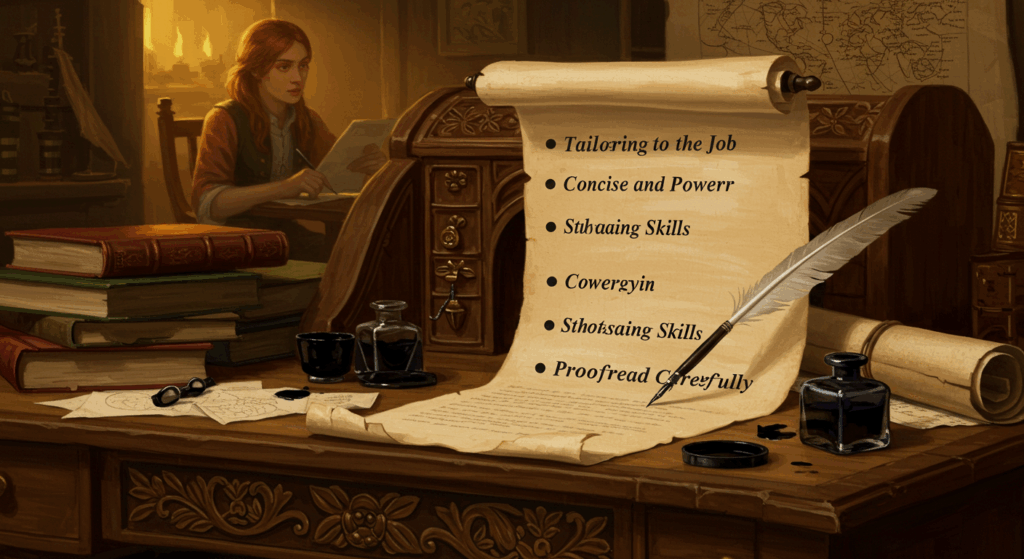If you’re staring at a blank Google Doc thinking, “what even is a cover letter, and why do I suddenly feel like I’m writing a college admissions essay again?” — same. A cover letter is basically your “hey, I’m a real human” message to the hiring team. It gives context to your resume, shows your voice, and answers the quiet question every manager has: “Will this person actually make my life easier?”
Here’s the deal though: there isn’t one correct way to write a cover letter. There are different types, plenty of variations, and a bunch of actually helpful examples depending on your situation. Applying cold? Switching careers? Moving cities? I got you. We’ll talk through the big buckets, when to use each, and quick snippets you can literally copy-paste and tweak. We’ll keep it friendly, lightweight, and ngl—slightly imperfect, like a real person wrote it (because you did!).
Grab a coffee, open your notes app, and let’s make this way less scary than it looks on those super formal templates with microscopic fonts.
What a Cover Letter Actually Does (and Why It’s Not a Novel)
A good cover letter gets three things done fast:
- Connect the dots. Your resume says what you did; your letter says why it matters for this job.
- Signal fit. You match the top 3–5 job needs with quick proof (numbers, outcomes, receipts).
- Start a convo. You’re not trying to write Shakespeare. You’re trying to get an interview.
Length? Think one page (or around 250–450 words). If it’s an email “cover note,” even shorter is cool. And tone-wise, not a robot. Professional but relaxed. Like “I can lead a sprint review and also choose the right meme for Slack.”
When You Actually Need One (and When a Short Note Beats a Full Page)
- Traditional applications through company portals: yes, attach a proper PDF letter unless they say “no cover letters.”
- LinkedIn Easy Apply: a tight short email cover note in the text box is often better than attaching a novel no one will open.
- Cold outreach to a founder/manager: use a letter of interest (aka speculative letter) — short, punchy, value-forward.
- Internal moves, referrals, or niche roles: still use a letter, but pick the right type from below.
Okay, let’s get into the types, variations, and examples so you can pick the right flavor and be done with this in, like, one playlist.
The Main Types of Cover Letters (With Examples & Variations)
Below, you’ll find the most common types of cover letters you’ll run into — plus variations and short examples you can adapt. Choose the one that matches your scenario (it’s normal to mix and match). Think of this like Netflx categories: “because you watched career change docu-series, you might also like internal transfer letters.”
1) Classic Application Cover Letter (the “I’m applying to this posted job” one)
When to use: You found a role on a job board or company site. You’re a legit match.
Goal: Mirror the JD’s top needs and give 2–3 pieces of proof you’ve done the same thing successfully.
Structure:
- Hook (why this company + role)
- 2–3 bullets or mini paragraphs of proof (numbers help)
- Close with a call to action (CTA)
Mini example:
Hi Maya — I’m excited to apply for the Social Media Manager role at BrightBean. Your push into short-form video is exactly where I’ve spent the last two years.
At Acorn, I launched a TikTok series that grew to 285K followers in 9 months and drove a 23% lift in referral traffic. I also built a creator playbook that cut production time by 30% while doubling output.
I’d love to bring that repeatable system to BrightBean’s creator program. Could we set up a quick chat next week?
Variations: Add a quick P.S. with a portfolio link or “I noticed you recently launched X — here’s a fast idea.”
2) Referral Cover Letter (when someone waved you in)
When to use: An employee or mutual connection said “send me your resume, I’ll pass it along.”
Goal: Leverage trust. Name your referrer early (with permission), then quickly show proof you match the role.
Mini example:
Hi Len — Jordan Patel suggested I reach out about the Product Analyst role. We worked together at Zephyr, and he thought my A/B testing chops would fit your growth team.
In my last role, I led experiments that improved trial-to-paid by 11% and reduced churn in the first 30 days by 6%. I’m fluent in SQL, dbt, and prefer dashboards that people actually use (wild concept, I know).
If helpful, happy to share a brief deck of experiment write-ups. Thanks for considering — would love to connect.
Variations: If the referrer is senior, keep it crisp and confident. If they’re a peer, add one specific project you both collaborated on.
3) Cold Letter of Interest (aka speculative outreach)
When to use: You want to work there even if there’s no open role posted, or you spotted a pain you can solve.
Goal: Show you understand their world; pitch a concrete way you can create value.
Mini example:
Hey Carla — I’m a lifecycle marketer who’s been a fan of Finch’s newsletter (especially the loyalty breakdown last Friday). Noticed you’re expanding into Europe — congrats!
I’ve set up multi-language onboarding flows at two SaaS brands. Results: +18% activation in DE/FR, +13% in ES within three months. If you’re exploring a localized lifecycle stack, I’d love to share a 1-page plan.
Variations: Add a Loom link walking through a teardown. That combo (short note + micro-deliverable) is chef’s kiss.
4) Networking Letter (not applying… yet)
When to use: You want advice, a warm intro, or insight before applying.
Goal: Ask for a small, clear thing (15-minute chat, 2 questions by email) and show you’ve done your homework.
Mini example:
Hi Rina — I’m exploring product marketing roles in climate tech and loved your post on user research in hard-tech. I have two quick Qs on your PMM hiring rubric — could I email them?
If you have 10–15 minutes next week, I’d also be grateful for a quick call. Either way, thank you for sharing your work — it’s been super helpful.
5) Internal Promotion or Transfer Cover Letter
When to use: You already work there and want the new role.
Goal: Map your company knowledge to the new team’s outcomes. Managers love low-ramp candidates.
Mini example:
Hi Diego — I’m applying for the Senior CS role on Enterprise. In SMB, I’ve owned our top 50 accounts by expansion for the last 18 months (122% NRR).
I built our “renewal risk early-warn” report that Enterprise adopted last quarter; happy to extend it for your book. With a larger, more technical customer set, I’d focus on QBRS aligned to product roadmap and Exec sponsor playbooks.
Variations: Include internal impact (processes you created, cross-team wins, documented SOPs).
6) Career-Change Cover Letter (you’re pivoting)
When to use: Your resume doesn’t scream “perfect fit,” but your transferable skills do.
Goal: Translate your past into their needs, explicitly. Call out an “experience bridge.”
Mini example:
Hi Sam — After 4 years in hospitality operations, I’m shifting into People Ops. On paper, that may look like a leap; in practice, it’s been my day-to-day.
I’ve led scheduling and onboarding for 90+ staff across three locations, built training SOPs that cut ramp time by 25%, and mediated gnarly shift conflicts without burning bridges. I’m pursuing a People Ops certificate to formalize the knowledge side, too.
Variations: Use a T-format (see #9) to visually map old skill → new requirement. Works great for pivots.
7) New Grad / Entry-Level Cover Letter
When to use: You’ve got projects, internships, or class work, not years of job experience.
Goal: Lead with outcomes from projects, show curiosity and potential, tie to the company’s mission.
Mini example:
Hi Team — I’m a recent CS grad focused on ML and human-centered design. Last semester I built a small LLM-powered summarizer (Python + FastAPI) that cut reading time for 300+ students by ~40% in a pilot.
I care about building products that reduce noise (not add it). I’d love to learn from your team and ship quickly on the new Notes feature.
Variations: Replace GPA with project links. Recruiters love examples they can click more than a list of courses.
8) Short Email Cover Note (the “lite” version)
When to use: Easy Apply, recruiter DMs, or when the platform has a tiny text box.
Goal: 4–7 sentences max. One result. One ask.
Mini example (super short):
Hi Olivia — Applied for your Lifecycle Marketer role. I grew trial-to-paid +19% at Bloom via segmentation + onboarding experiments (can share a 1-pager). Would love to chat this week if you have 15 minutes.
Variations: Add 2 links: portfolio + LinkedIn. Keep it snackable.
9) T-Format Cover Letter (requirements vs. what you’ve done)
When to use: The JD is crystal clear with must-haves; you’re matching line-by-line.
Goal: Build a two-column body (Requirements | My Experience). ATS-friendly and manager-friendly.
Mini example (body only):
Requirements | My Experience
- Own A/B testing roadmap | Led 40+ tests; +11% signup conversion
- SQL fluency | Daily SQL; wrote 200+ queries, optimized 8 slow reports
- Build lifecycle journeys | Launched 3 journeys → +23% activation
Variations: Great for career change or technical roles. You can deliver it as plain text in the email too.
10) Pain Letter (solve a specific problem)
When to use: You see a glaring issue or opportunity and can fix it.
Goal: Prove you understand their pain, then pitch a micro-plan.
Mini example:
Hey John — I noticed Lighthouse’s mobile NPS dipped on the latest release (based on app store reviews the last 30 days). I’ve led 3 rapid “triage sprints” at B2C apps post-release with a similar pattern.
If helpful, I can share a 1-week template we used to stabilize ratings (+0.6 in 14 days). Happy to adapt it to your stack.
Variations: Include a one-screen teardown. Keep tone respectful — you’re offering help, not dunking.
11) Portfolio-Driven / Creative Cover Letter
When to use: Design, writing, video, dev portfolios — anything where your work sells you.
Goal: Tell the story behind 1–2 pieces — the brief, your choices, the result.
Mini example:
Hi Bea — Linking a 30-sec reel of micro-animations I designed for onboarding (reduced skip rate from 34% → 18%). Here’s a Figma file showing variations A/B/C and why C won. I’d love to bring that “clear, delightful, fast” energy to your growth pod.
Variations: Use a P.S. with one killer piece (“P.S. quick Figma playground here with 3 alt concepts”).
12) Technical / Quant-Heavy Cover Letter
When to use: Data, engineering, analytics, fintech, etc.
Goal: Lead with stack + outcomes. Keep jargon readable.
Mini example:
Hi Team — I’m a data engineer with 4 years on ELT pipelines (Airflow, dbt, BigQuery). I led our migration off brittle cron jobs to managed workflows, cutting failure rates by 92% and pipeline cost by ~28%.
I partner closely with analysts to make dashboards actionable (we sunsetted 19 zombie reports last quarter). Happy to share before/after diagrams if helpful.
Variations: Swap in examples of incident response, SLAs, or cost/perf wins.
13) Relocation Cover Letter
When to use: You’re moving and need to neutralize the “are they really relocating?” doubt.
Goal: State your move date + show you’ve thought through logistics.
Mini example:
Hi Amari — I’m relocating to Austin in November for family reasons and am applying to the CX Lead role. I’ll be in town the week of Nov 10 and can start Dec 2.
I’ve led support for two SaaS tools with 97% CSAT and built the macros that cut first response time by 38%. Would love to bring that playbook to your team.
Variations: Offer the first conversation via Zoom; note you’re handling relocation yourself if true.
14) Return-to-Work / Career Break Cover Letter
When to use: You took time off (caregiving, health, travel, etc.) and you’re ready to re-enter.
Goal: Normalize the gap without oversharing; highlight relevant upskilling.
Mini example:
Hi — After a planned career break, I’m excited to return to project management. During the gap I completed a PMP-aligned course, volunteered on a local nonprofit website rebuild, and kept my Jira/Confluence chops fresh.
Pre-break, I shipped 12 projects on time over 2 years. Happy to share references from the volunteer team lead as well.
Variations: If you did freelance or consulting during the gap, include 1 tangible outcome.
15) Nonprofit / Mission-Driven Cover Letter
When to use: The org is impact-first and expects values alignment.
Goal: Tie your story to the mission and show operational excellence.
Mini example:
Hi Aya — I’m applying to your Programs Manager role because financial literacy changed my life — I was the first in my family to graduate college, and budgeting classes were my turning point.
In my last role, I scaled a volunteer network from 40 to 180 mentors and built the scheduling system that doubled attendance. I’m excited by your youth accelerator and would love to help expand it statewide.
Variations: Include community ties, languages, or local partnerships — examples matter here.
16) Executive / Leadership Cover Letter
When to use: Senior roles where the board/CEO wants clarity and outcomes.
Goal: Tell a crisp business story: scale, turnaround, markets, teams, and results.
Mini example:
Chair and Search Committee — Over the last 3 years I led a product-led transformation from services → SaaS, reaching $24M ARR with 128% NRR and a CAC payback under 11 months.
I’m applying for your COO role to scale the next $20M: GTM operating rhythm, supply chain resilience, and a hiring playbook for frontline leaders.
Variations: Use a short “value thesis” bullet list (90-day priorities) as the body.
17) International / Cross-Cultural Cover Letter
When to use: Applying across borders, or to a globally distributed team.
Goal: Address work authorization if relevant, highlight cross-cultural comms.
Mini example:
Hi Hiring Team — I’m a bilingual (EN/ES) product marketer with experience launching across LATAM and EU. I’m eligible for [visa detail] and have coordinated with legal for timelines (happy to outline).
Most recently, I localized messaging for 4 markets and launched partnerships that drove 17% of new ARR.
Variations: Add examples of async practices (docs, Looms, clear handoffs).
18) Startup / Early-Stage Cover Letter
When to use: You’re applying to a small team that values builders and generalists.
Goal: Show bias to action, scrappy wins, and comfort with ambiguity.
Mini example:
Hey Jess — I love small teams where you ship before lunch. At Kettle (6→22 ppl), I owned “whatever gets growth,” from landing pages (Webflow) to onboarding emails to founder sales support.
Shipped 40+ experiments in 6 months; 7 moved needle: +21% activation, +13% MRR. Happy to jump on fires and build the firehose too.
Variations: Include a 7-day mini plan tailored to their product (seriously powerful).
19) ATS-Friendly Cover Letter (keyword-aware but human)
When to use: Portals that clearly screen hard on keywords.
Goal: Mirror the language of the JD naturally (don’t spam), keep formatting simple, avoid heavy design.
Mini example:
Hi Hiring Team — I’m applying for the Senior SEO Strategist role. My background includes technical SEO audits, content strategy, site migrations, and A/B testing for on-page improvements.
Recent impact: Resolved 1,300 crawl issues, improved Core Web Vitals (CLS 0.08), and grew organic sessions +38% YoY. Tools: GA4, GSC, Screaming Frog, Looker Studio.
Variations: Add a short keyword list in your last paragraph (again, natural language).
20) Post-Interview Thank-You / Follow-Up (yes, it’s a type)
When to use: After interviews, or when a deadline passes and you want to nudge.
Goal: Reinforce fit, recap one insight from the convo, and restate your value.
Mini example:
Hi Priya — Thank you for the thoughtful conversation today. I keep thinking about your product-education challenge; the “starter path” lens resonated.
I’ve built two similar paths that cut time-to-value from 10→4 days. If helpful, I can sketch a 1-pager for your next sprint. Appreciate your time!
Anatomy of a Strong Letter (Whatever Type You Choose)
No matter the types and variations, great letters share the same DNA:
- A specific hook: “I admire your recent X” beats “I’m excited to apply.” Show you did the homework.
- One or two outcomes: Numbers > adjectives. “Cut churn 6%” smokes “strong team player.”
- Plain language: Write like a human who knows how to get stuff done.
- Proof links: Portfolio, GitHub, writing samples, case studies. Real examples build fast trust.
- A clear ask: “Could we set up a quick call?” or “Open to a 15-minute intro?” Make it easy to say yes.
- Formatting sanity: Clean fonts, 10–12 pt, normal margins, your contact at the top, one page-ish.
- Company-first framing: Tie every bullet to their goals, not your autobiography.
Pro-tip: Borrow job-description nouns/verbs, but don’t copy paste. If they say “build lifecycle journeys,” say “built lifecycle journeys,” not “I’m a ninjA wizard synergy guru” (lol pls no).
Quick Templates You Can Tweak (Plug & Play)
Use these short skeletons to go from “blank page panic” to “done” in 10 minutes. Pick the type, add your examples, and tweak the variations.
Classic Application (Template)
Hi [Name] — I’m applying for [Role] because [specific company reason].
In my last [role/company], I [result 1 with number], and I [result 2 with number]. I’m strongest in [skill 1], [skill 2], and [skill 3 relevant to JD].
I’d love to bring that to [Company], especially on [team/project]. Could we set up a quick chat next week?
Career Change (Template)
Hi [Name] — I’m transitioning from [old field] to [new field]. While my title says [old job], my day-to-day mapped closely to [new job tasks].
Highlights: [transferable skill + example], [project + metric], [tool/process]. I’m currently upskilling via [course/cert/mentorship].
I’m ecited to apply this foundation to [Company]’s [goal/team].
Cold Letter of Interest (Template)
Hey [Name] — Big fan of [product/content]. I noticed [opportunity/pain].
I’ve done [relevant project] resulting in [metric]. If you’re exploring [initiative], I can send a 1-pager with a quick plan. Open to a 10-minute chat?
Short Email Cover Note (Template)
Hi [Name] — Applied for [Role]. My recent work: [one crisp result + tool/context]. Links: [portfolio/GitHub/LinkedIn]. Could we talk for 15 minutes this week?
T-Format (Template Body)
Requirements | My Experience
- [Requirement 1] | [Your matching example + metric]
- [Requirement 2] | [Your matching example + metric]
- [Requirement 3] | [Your matching example + metric]
These keep you on-message and make switching types painless depending on the role.
Common Mistakes (No shame, we’ve all done them)
- Rewriting your resume. Your letter should frame your resume, not duplicate it line-by-line.
- Talking only about yourself. Make it about their outcomes. “You → We → I” is a nice flow.
- Buzzword salad. If a sentence doesn’t mean anything, delete it. (I promise the hiring manager will thank you.)
- Zero specifics. Add one metric, a tool, a link, or a tiny story. Those are the examples that stick.
- Ignoring the ask. End with a concrete CTA: time, format, and next step.
- Typos everywhere. One or two little “hmm, you know” moments are fine for voice, but run a quick spellcheck pass, pls.
How to Personalize at Scale (so you’re not writing forever)
- Build a “wins bank.” Keep a running doc of your outcomes with numbers and context. Copy-paste city.
- Create three master templates (Application, Cold, Short Email). Swap hooks and the middle proof chunk.
- Mirror the JD language. Not every word, just the important nouns/verbs.
- Batch in sprints. 3–4 applications in a 90-minute block, then reward yourself (snacks, Netflix mini-episode, quick walk).
- Use a P.S. for extra spice. “P.S. I sketched 3 subject line variations — happy to share if helpful.” Little things get replies.
Real Talk: Tone, Voice, and Vibes
You don’t have to be hyper-formal to be professional. Think: clear, kind, capable. Throw in a little personality — a single “ngl” or one fun line is cool; five emojis and a SpongeBob meme probably not (unless you’re applying to a meme account, then go off).
Also, if writing in English isn’t your first language, keep it simple. Short sentences are your friend. Many managers prefer crisp over fancy anyway. We all skim (sorry not sorry).
FAQs About Cover Letter Types, Variations, and Examples
Do I always need a full page?
Nope. For a lot of roles (especially via LinkedIn), a short email note with one great result and a link wins.
Can I reuse the same letter?
Reuse structure, not content. Update the hook, swap in relevant examples, and mirror a few JD keywords.
What if I don’t have metrics?
Use examples of scope (team size, stakeholders, platforms) or speed (launched in 3 weeks), plus quality signals (NPS, testimonials, fewer bugs).
Where do I put salary/visa/relocation?
Not in the first letter unless the posting explicitly asks. For relocation, a simple one-liner is fine (“I’m moving to Austin in Nov and can start Dec 2.”)
Is a P.S. weird?
Not at all. P.S. lines are magnetic for skimmers. Keep it short and useful (link, idea, optional extra).
A Tiny Swipe File You Can Steal (Subject Lines + Closers)
Subject lines for email cover notes (choose your vibe):
- “Application: Lifecycle Marketer — quick wins inside”
- “Referral via Jordan Patel — Product Analyst”
- “Idea for your onboarding drop-off — 1-pager”
- “Austin relocation — CX Lead application (Dec start)”
Closers that don’t sound stiff:
- “Open to a 15-minute chat next week?”
- “Happy to send a one-pager with details.”
- “If it’s helpful, I can share the experiment write-ups.”
- “Either way, appreciate your time — thanks for reading!”
Putting It All Together (Fast Checklist)
Before you hit send, run through this speedy checklist — works across types and variations:
- A clear hook that shows you know the company.
- 1–3 proof points with examples (ideally numbers).
- Links to portfolio, GitHub, writing, or case studies.
- Language that mirrors the JD without overdoing it.
- A specific CTA (time, next step).
- Clean formatting (no funky fonts, no walls of text).
- File name sanity:
FirstName-LastName-Cover-Letter-Company.pdf.
If you can check those off, you’re probably 90% there. The remaining 10%? Confidence and hitting “send” without tinkering for 4 more hours (we’ve all been there, doom-editing at 1 a.m.).
Final Takeaway: Choose the Type, Add Your Proof, Ship It
Cover letters aren’t exams. They’re little conversations where you say, “Here’s how I can help you win,” backed by a couple of solid examples. Pick the right type for your situation — classic application, referral, cold letter, short note, T-format, pain letter, career change, you name it — then tailor the middle with your best wins. Those small, human variations are what make you memorable.
You’ve got this. Seriously. Pick a template above, swap in two outcomes, and send three applications today. Future-you (and your bank account) will be very, very happy.
Ready? Open your notes, choose your cover letter type, and ship the first one in the next 30 minutes. Let’s go. 🚀









